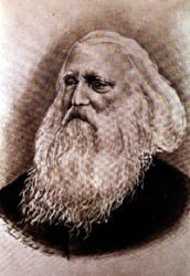 Click here to view or download a PDF.
Click here to view or download a PDF.
Ross Wilkins was born on February 19, 1799 in Pittsburgh, Pennsylvania to John Wilkins, Jr. and Catherine Wilkins. He attended and graduated from Dickinson College. Wilkins studied law in Pittsburgh and held the office of Prosecuting Attorney when he was only 21 years old, from 1821 – 1823.
Wilkins married Maria Duncan on May 13, 1823, and continued to live in Pittsburgh and practice law. He served as a member of the Pennsylvania House of Representatives from 1829 – 1830.
President Andrew Jackson appointed him to a new seat authorized by 5 Stat. 61 as U.S. District Court Judge for the Michigan Territory. He was confirmed by Senate vote on July 2, 1836. He received his commission on January 26, 1837. During 1837, he also held the judicial office of Recorder of the City of Detroit, discharging the duties of the federal court as well. Upon the admission of Michigan into the Union, Wilkins was appointed a United States District Judge. He also served on the Board of Regents for the University of Michigan from 1837 until 1842. When the state was divided into two federal judicial regions, Wilkins was appointed the judge for the U.S. District Court for the Eastern District of Michigan. This office he held until his voluntary retirement on February 18, 1870 at the age of 71 years.
Judge Wilkins was involved with the Underground Railroad in Detroit. He worked with George DeBaptiste and Laura Haviland to save the Gordon family from being taken into slavery. The story is revealed by Michigan’s Laura Smith Haviland in her autobiography, A Woman’s Life-Work. Haviland provided a home to the Hamilton, later known as Gordon, family on her farm located near Adrian Michigan. A Tennessee man claimed the Hamiltons as his property and attempted to capture them in the 1840s. The Hamiltons were able to escape to Canada and were living there in 1850 when the slave owner’s son, Thomas K. Chester, returned to Michigan.
Chester learned the Hamiltons were in Canada but thought they might be in Ypsilanti. Chester identified a family that resembled the Hamiltons (from 18 years earlier) and were now living by the name Gordon. Following the provisions of the 1850 Fugitive Slave Act, Chester applied for a warrant to take the family. Haviland reported, “The United States Judge, Hon. Ross Willkins, who issued the warrant, informed one of the most active underground railroad men, George DeBaptiste” of Chester’s claim.
DeBaptiste worked with an Underground Railroad worker in Ypsilanti, who was unable to find the Hamilton/Gordon family. Fortunately, when an officer and Chester entered the Gordon house, Gordon produced their free papers and Chester was forced to withdraw his claim. Chester returned to Wilkins and accused him as a conspirator with Haviland. The Chester family led an unsuccessful campaign to impeach Wilkins as a conspirator and “rabid abolitionist.”
In 1845, Wilkins undersigned the committee endorsing Henry Bibb’s narrative of his life in bondage and escape to freedom. This public recommendation solidified Wilkins’ reputation as an abolitionist.
Wilkins also presided over the second trial of Giltner v. Gorham in November 1848. Wilkins allowed freedom seeker Adam Crosswhite to take the stand and then return without arrest to his refuge in Canada.
For 38 consecutive years, Wilkins held a judicial office in the Territory and State of Michigan, and for many years he was prominent in Territory and State politics. Wilkins was a member of the convention that drafted the Michigan Constitution of 1835, and also of the two conventions held in 1836 to accept terms imposed on Michigan statehood by Congress. The services of Wilkins covered the most critical period marking Michigan’s transition from Territory to Statehood.
Judge Wilkins died on May 17, 1872 and is buried in Section 1, Lot 7.
Wilkins is listed in Elmwood’s Underground Railroad Network to Freedom Self-Guided Tour Map.

This material is based upon work assisted by a grant from the Association for the Study of African American Life and History (ASALH), funded by the Department of the Interior, National Park Service. Any opinions, findings, and conclusions or recommendations expressed in the material are those of the author(s) and do not necessarily reflect the views of ASALH or the Department of the Interior. Elmwood Cemetery’s Network to Freedom Application was completed by Carol Mull and Gabrielle Lucci. This biography was completed based upon the Application and records available through Elmwood Cemetery, Detroit Historical Society, Burton Historical Library, Military Records of the United States, Michigan Historical Center, and various information sources.
